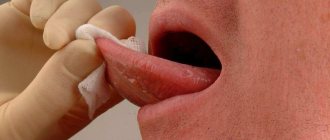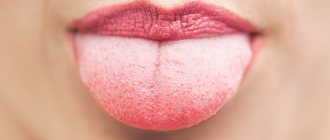If whiteheads don't hurt
The tongue is an important organ. Its condition shows how the internal organs work. It affects speech formation, digestion, and communication functions. Stains on it are common. They may appear during dental treatment. Injury to the mucous membrane causes pathological manifestations. This can happen when the patient wears dentures. It happens that specks on the surface of the tongue do not bother patients. In such cases, they do not go to the dentist. This behavior is wrong. You need to see a doctor to rule out serious abnormalities. Most teenagers, during the period of hormonal changes, develop spots with a whitish tint in the oral cavity. They are even visible in the folds between the gum tissue and the lip. In addition, there are many more provoking factors.
Reasons for appearance
A common cause is gastritis. This disease is characterized by a whitish coating of the mucous membrane. There is no pain in the mouth, but there is a feeling of dryness, and taste sensitivity is dulled. The following circumstances lead to the problem:
- Long-term use of certain medications.
- Taking drugs.
- Weakness of the body's defenses.
- Excessive consumption of curd products and sweets.
- If you do not properly care for the oral cavity, food debris accumulates between the papillae, where bacteria form.
- Unsuitable mouthwashes and toothpastes.
- Improper daily routine, frequent overwork.
- Eating disorders.
- Worm infestation.
A newborn baby may have a whitish tongue. There is no need to worry if the plaque is small, thin, and the mucous membranes are moist; the problem disappears after cleansing procedures. For stomatitis, candidiasis and other diseases, therapeutic measures are mandatory.
Treatment
A white spot on a child’s tongue should alert every parent, especially if it is an infant. Is treatment necessary? The pediatrician will determine this.
- If the toddler has just consumed cottage cheese, sweets, and dairy products, therapy will not be needed.
- When thrush is observed in the oral cavity, it needs to be dealt with. It often appears in weak and premature newborns, in those children who are artificially fed.
- You should consult a doctor when your little one has stomatitis, that is, inflammation of the oral mucosa, glossitis, tonsillitis, pharyngitis.
- Complex treatment requires scarlet fever, diphtheria, and diseases of the gastrointestinal tract.
The therapeutic program is developed by a pediatrician, pediatric dentist, gastroenterologist, endocrinologist and other specialized specialists. In case of a traumatic factor, braces are adjusted, in case of an allergic reaction, the allergen is excluded. Antifungal medications are prescribed against candidiasis, and antiseptic rinses are also recommended.
Prevention
To prevent problems, professional oral hygiene should be performed regularly. Even “harmless” soft plaque must be removed regularly, so it will not harden and turn into stones. Cleaning the oral cavity in a dental office will help avoid caries, gingivitis and periodontitis.
To prevent problems with the mucous membranes of the oral cavity, you need to thoroughly clean the chewing organs, cheeks, palate, and tongue. The procedure is carried out twice a day: morning and evening. This will prevent the development of painful microorganisms. Don't forget to visit the dentist once every 6 months. The use of special scrapers is recommended. It is necessary to diversify the patient's diet. You should eat more foods that contain iron.
Non-dangerous causes of appearance
The causes of red dots on the tongue that are not dangerous are:
- Eating foods colored red.
- Eating very hot or spicy food.
- Irritation or injury from wearing dentures.
- Changes in bite after visiting the dentist.
- Tongue burn.
- Allergic reaction to toothpaste and other oral hygiene products, food products.
- Smoking.
If none of the above explanations are found in a person, it is necessary to look for reasons of a more serious nature. The most common ones should be considered.
If whiteheads hurt
The tongue is an indicator of health. Everyone should remember this. This organ should be examined regularly. At the first problem, you need to contact your dentist. Its structure is such that it has many small spots, but they are invisible. If white spots on the tongue of an adult or child cause severe irritation, such a symptom cannot be ignored. This may indicate health problems.
An adult often remembers this organ when it hurts, when discomfort, burning or unpleasant sensations begin, including ulcers and cracks.
Reasons for appearance
A doctor can accurately determine the provoking factor. Often problems arise due to the following diseases:
- Thrush or candidiasis. This fungal disease can cause dry mouth, even bleeding from the sores.
- Problems with the gastrointestinal tract.
- The appearance of lichen planus may be associated with hepatitis. Pathological areas are rich white in color and peel off.
- Excessive smoking, chewing tobacco use. Patients experience burning and soreness.
- Colds, infectious diseases. In such cases, increased salivation and swelling appear.
With stomatitis, whitish specks appear in large numbers. They can merge into one spot. Most often they appear at the tip, at the base, or on the side of the tongue. These areas are sharply painful; patients complain of itching, which intensifies after eating.
Treatment with medications
Removing dental plaque is the prevention of the appearance of pathologies in the oral cavity. The process is carried out in a dental office. It is important that cleaning is carried out systematically, then the patient will be protected from abnormalities of the mucous tissue. If the disease appears, therapy is prescribed by a doctor after determining the exact cause.
- The oral cavity is carefully treated with an antiseptic solution, such as furatsilin, chlorhexidine.
- If the provoking factor is an infection, antiviral drugs, anti-inflammatory drugs and antibiotics are prescribed.
- To clarify the diagnosis, the dentist prescribes tests for the patient.
- If the problem arose due to a poorly placed or old filling, the destroyed cement is replaced with a new one after cleaning the carious cavity.
For baths and compresses, anesthetics are used in dissolved form. Plaque from mucous tissues is removed with a cotton swab, which is moistened with an antiseptic substance. Wounds are treated with healing ointments. If ulcers appear, they are opened surgically. To increase the body's defenses, vitamins and immunomodulators are prescribed.
Treatment with folk remedies
Oral health is maintained at home with rinses. This will help destroy pathogens.
- Chamomile decoction is used as a rinse. To do this, you can brew sage and use a weak solution of potassium permanganate.
- A decoction of flax seeds, plantain, oak bark, and soda solution helps well.
- Vegetable oil is used as therapy. You need to keep it in your mouth for 10 minutes.
- To eliminate the burning sensation, traditional medicine recommends briefly putting chopped garlic on the tongue.
- Gargling with potato juice eliminates inflammation and pain.
For a speedy recovery, all these procedures must be performed in addition to the main therapy.
Features of changing the type of language
The whitish plaque in the form of dots that covers the surface of the tongue is formed due to the fact that the cells of the miniature papillae become rough and keratinized. This phenomenon is caused by:
- the presence of infection inside the body;
- problems with the digestive tract;
- taking pharmaceutical drugs;
- diseases .
How to quickly remove plaque from your tongue
If a person’s health is fine, the tongue has a faint pink tint. A small amount of plaque can be easily cleaned off. The papillae do not thicken. There is no specific smell.
You need to think about the presence of a possible pathology of some organ when a burning sensation or pain occurs, loss of taste, or a feeling of dryness. A sign of a developing health problem can be the fact that the back of the tongue changes color to yellow or gray, and redness appears on the sides. Enlarged papillae become like bright spots.
A plaque is visible on the swollen surface. If you clean it, the dots form again.
Treatment method
Treatment that will allow you to get rid of white spots on the tongue is prescribed taking into account the identified pathologies. If they are not eliminated, the plaque will form again. Sometimes the problem goes away just by changing your diet and eating habits. Often it is necessary to treat the oral cavity, remove decayed teeth, and remove unsuitable dentures and braces.
When an infection, bacteria or fungi, is detected, a whole range of drugs is prescribed to help cure them. When the body's protective functions are weakened, immunomodulators are used and vitamins are consumed.
If plaque appears due to candidiasis, the mouth should be rinsed well with a soda solution. White dots are cleaned off with sterile cotton wool or a special brush that has a ribbed surface. The tongue and mucous membranes are treated with antiseptics in the form of a solution of Tantum Verde, Rivanol or chlorhexidine.
Let's find out how to remove white plaque on the root of the tongue
Nystatin ointment is applied, which prevents the fungus from spreading. Relieve inflammation with Corsodil. Wounds will heal faster when using aloe liniment, sea buckthorn oil or rosehip oil.
At home, you can get rid of glossitis only at the beginning of its development, if the surface of the tongue is injured by a burn or mechanical force, since self-treatment can lead to a complicated form.
To prevent whiteheads from causing discomfort, you need to prevent their occurrence. Germs will not develop in the oral cavity if you do not forget to brush your teeth. To prevent pathology, products must contain retinol, vitamins B and C. It is worth stopping smoking, abusing alcohol, drinking less coffee and tea, and not indulging in sweets.
Rinsing your mouth with an infusion brewed from chamomile, calamus or calendula helps speed up recovery.
Types of plaque in pathologies of the digestive organs
Acute gastritis is accompanied by nausea and stomach pain. White dots appear on the surface of the tongue. In the chronic form, the plaque takes on a yellowish or gray tint, and the papillae become inflamed. A person suffers from belching and heaviness in the stomach.
The ulcer is characterized by whitish dots that find a place on the root of the tongue. There is an unpleasant burning sensation. With pancreatitis, taste is lost and the mouth feels severely dry. The patient suffers from attacks of severe pain.
With stomach cancer, the entire cavity, and not just the tongue, is covered with a dense coating, from which a rotten smell emanates. It appears due to the release of decay products, the presence of pathological microorganisms, and a large number of leukocytes.
Features of plaque in galvanic stomatitis
With galvanic stomatitis, a white coating may appear if there are metal dentures in the mouth that cause irritation. This phenomenon occurs when, when installing them, it was not taken into account that a person has problems with his bite.
Sometimes the tongue is damaged by braces or sharp edges of the tooth. White formations are formed from the remains of the epithelium and pus. They are able to give way to a bleeding ulcer and then a cancerous tumor.
Glossitis, in which the papillae become inflamed, is often preceded by injury to the tongue when biting into hard food. The cavity can be scratched by bone.
9 reasons for the formation of a brown coating on the tongue in adults
Multiple whitish spots can form after taking antibiotics for a long time, since they fight not only bacteria, but also beneficial microflora. There is a plaque in people who have been smoking a lot for a long time. This pathology is called leukoplakia.
The appearance of pimples in the area of the tongue root can be caused by toothpaste containing anise or eucalyptus oil.









